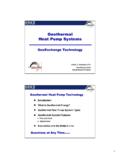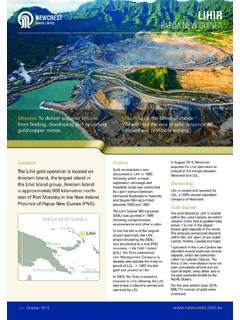Transcription of Infrastructure investments - EY - United States
1 Infrastructure investments An attractive option to help deliver a prosperous and sustainable economyContentsExecutive summary03 Introduction04 Current state of the Infrastructure investments market07 The evolving regulatory climate current requirements and Solvency II12 Operational management of Infrastructure assets17 Appendix21 Conclusion223 Infrastructure investmentsIn today s low-yield environment, insurers are under increasing pressure to source additional investment return. Infrastructure investments may present an opportunity for insurers to achieve the required yields to cover future liabilities and provide competitively priced products.
2 This is due to the fact that typical loans have historically outperformed comparative traditional particular, the treatment of Infrastructure loans under risk-based capital regulatory regimes, such as Solvency II, could be attractive relative to more traditional institutional investments . However, one should note that, although the capital charge may not necessarily inhibit this investment , a treatment that reflects the underlying economic risk of the asset class will likely enable insurers to commit more money to the investments are an interesting option for an insurer s portfolio, as they provide.
3 Potentially lucrative risk-adjusted return on equity Long-term risk exposure, which may provide a good match for long-term liabilities Illiquidity and sector-diversity, which could increase portfolio diversification An opportunity to lend money to sectors in need of funding, leading to social and potentially reputational benefitsThere are practical issues, however, which an insurer should consider prior to investment , including: Determining whether margins are sufficient to cover the costs and risks associated with operational complexities, such as sourcing, managing and pricing Infrastructure investments Putting in place suitable processes to assess and manage Infrastructure debt investment Investing in Infrastructure that is best suited to their balance sheet and risk profile (these opportunities have been limited because issuances have historically been influenced by banking requirements)
4 As a result of these considerations, the insurance industry has made only a marginal investment in the Infrastructure sector in recent years. However, there is increasing interest as insurers find that the benefits of Infrastructure assets outweigh the apparent costs relative to the low yields available on more traditional investments . The typical annual benchmark spread achieved by Infrastructure investments is comparable to A- and BBB-rated corporate bonds of a similar duration (as indicated by our analysis in this paper) with spreads ranging from 125 160bps for non-publicly rated private finance initiative (PFI)/public private partnership (PPP) Infrastructure considered of A to BBB Executive summarycredit quality by lenders.
5 These relatively competitive spreads may be seen as attractive, with our analysis indicating that the achievable return on equity may be greater than that for A- or BBB-rated corporate bonds of a comparable duration under the Solvency II regulatory , the source of preferred insurer investments has been limited. Increased interest in a concentrated sub-sector of the market has contributed to tightening margins on the most attractive investment opportunities. Therefore, insurers should understand the requirements of the Infrastructure market to suitably influence the availability and attractiveness of this paper, we have identified a selection of historic deals and pipeline opportunities which may be well suited to an insurance investor.
6 We explore the operational complexity of such an investment , and analyze the materiality of such risks, including the possible mitigation options available to insurers. 4 Infrastructure investmentsThe definition of the Infrastructure asset class can be very broad. One definition is facilities or structures required for the effective operation of a business, state or economy. In this paper, we define Infrastructure to include roads, railways, airports, power generation and transmission, ports, communications, water and waste, together with social Infrastructure , such as hospitals, schools IntroductionTypes of infrastructureDescriptionExamplesGreenfi eld or brownfieldGreenfield projects involve an asset or structure that needs to be designed and constructed, where no Infrastructure or building previously existed.
7 Investors fund the building of the Infrastructure asset and the maintenance when it is Gemini offshore wind farm project involves the construction of two wind farms with a combined capacity of 600MW in the North Sea, off the coast of the Netherlands. It has an estimated completion date of Q4 2016 and a value of $ projects involve an existing asset or structure that requires improvement, repair or expansion ( , land where a building or construction already exists). The Infrastructure asset or structure is usually partially operational and may already be generating income. The road improvement of the A556 trunk road between Knutsford and Bowdon in the UK, creating a modern dual carriageway road.
8 The improvement works are expected to be completed by 2017 at a cost of between 165m and (primary) or operational (secondary) phasePrimary Infrastructure investments are those made at the pre-operational or construction phase, before most revenue is generated. Higher risk is associated with construction-phase projects due to completion and usage risks. The risk-return profile of Infrastructure , which is complex to construct, is similar to high-risk venture capital projects. However, the risks involved in projects with a more typical construction phase (such as schools and hospitals) are often bank-debt funded, and are lower risk than speculative construction projects given that they are subject to greater controls.
9 Note that a primary investment could be either greenfield or Johan Sverdrup Oil Field Development in Norway, which is expected to be completed in Q4 2019. The cost of the development is $ and involves installation of four fixed platforms and Infrastructure to export oil and Infrastructure investments apply to the operational stage of a project. There is a lower risk as construction has been completed and usage levels have been established; the risk also reduces over time if the project has proven to be revenue generating. This phase offers reliable long-term returns, although it still carries significant ongoing management challenges.
10 Note that a secondary investment could be either greenfield or Marmaray Project is a 76km subterranean railway development under the Bosporus Strait in Turkey. The project began in 2004, with the initial phase completed in 2013, following multiple delays due to archaeological or demand-basedAvailability-based projects are typically where the government, or some other sponsor, procures essential facilities or services in return for payments linked to availability rather than usage levels (this obligation is defined in the terms of the investment contract).Availability-based investments are typically lower-risk investments whereby equity cash flows can be debt like in their certainty and timing given that the exposure is to the sponsor rather than the profitability of the project.












